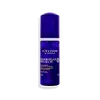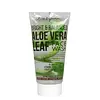What's inside
What's inside
 Key Ingredients
Key Ingredients

 Benefits
Benefits

 Concerns
Concerns

 Ingredients Side-by-side
Ingredients Side-by-side

Water
Skin ConditioningGlycerin
HumectantDecyl Glucoside
CleansingCaprylyl/Capryl Glucoside
CleansingSodium Cocoyl Glutamate
CleansingCoco-Betaine
CleansingHelichrysum Italicum Extract
AntiseborrhoeicGaultheria Procumbens Leaf Extract
PerfumingHelichrysum Italicum Flower Oil
MaskingLens Esculenta Fruit Extract
Skin ConditioningGlyceryl Oleate
EmollientCoco-Glucoside
CleansingLevulinic Acid
PerfumingSodium Chloride
MaskingPropylene Glycol
HumectantSodium Levulinate
Skin ConditioningCitric Acid
BufferingPentylene Glycol
Skin ConditioningTocopherol
AntioxidantHydrogenated Vegetable Glycerides Citrate
EmollientSodium Benzoate
MaskingParfum
MaskingWater, Glycerin, Decyl Glucoside, Caprylyl/Capryl Glucoside, Sodium Cocoyl Glutamate, Coco-Betaine, Helichrysum Italicum Extract, Gaultheria Procumbens Leaf Extract, Helichrysum Italicum Flower Oil, Lens Esculenta Fruit Extract, Glyceryl Oleate, Coco-Glucoside, Levulinic Acid, Sodium Chloride, Propylene Glycol, Sodium Levulinate, Citric Acid, Pentylene Glycol, Tocopherol, Hydrogenated Vegetable Glycerides Citrate, Sodium Benzoate, Parfum
Water
Skin ConditioningCocamidopropyl Betaine
CleansingDisodium Laureth Sulfosuccinate
CleansingSodium Cocoamphoacetate
CleansingDecyl Glucoside
CleansingPEG-120 Methyl Glucose Dioleate
EmulsifyingPEG-6 Caprylic/Capric Glycerides
EmulsifyingPhenoxyethanol
PreservativeParfum
MaskingCitric Acid
BufferingCaprylyl Glycol
EmollientAloe Barbadensis Leaf Extract
EmollientTetrasodium Glutamate Diacetate
Tocopheryl Acetate
AntioxidantRetinyl Palmitate
Skin ConditioningWater, Cocamidopropyl Betaine, Disodium Laureth Sulfosuccinate, Sodium Cocoamphoacetate, Decyl Glucoside, PEG-120 Methyl Glucose Dioleate, PEG-6 Caprylic/Capric Glycerides, Phenoxyethanol, Parfum, Citric Acid, Caprylyl Glycol, Aloe Barbadensis Leaf Extract, Tetrasodium Glutamate Diacetate, Tocopheryl Acetate, Retinyl Palmitate
 Reviews
Reviews

Ingredients Explained
These ingredients are found in both products.
Ingredients higher up in an ingredient list are typically present in a larger amount.
Citric Acid is an alpha hydroxy acid (AHA) naturally found in citrus fruits like oranges, lemons, and limes.
Like other AHAs, citric acid can exfoliate skin by breaking down the bonds that hold dead skin cells together. This helps reveal smoother and brighter skin underneath.
However, this exfoliating effect only happens at high concentrations (20%) which can be hard to find in cosmetic products.
Due to this, citric acid is usually included in small amounts as a pH adjuster. This helps keep products slightly more acidic and compatible with skin's natural pH.
In skincare formulas, citric acid can:
While it can provide some skin benefits, research shows lactic acid and glycolic acid are generally more effective and less irritating exfoliants.
Most citric acid used in skincare today is made by fermenting sugars (usually from molasses). This synthetic version is identical to the natural citrus form but easier to stabilize and use in formulations.
Read more about some other popular AHA's here:
Learn more about Citric AcidDecyl Glucoside is a glucose-based surfactant and emulsion stabilizer. It is created by reacting glucose with the fatty acids from plants.
Surfactants help clean the skin by trapping oil, sebum, and dirt to be washed away. As an emulsion stabilizer, it stabilizes the ingredients in a product by preventing them from separating.
This ingredient is biodegradable and non-toxic. This ingredient is commonly found in baby shampoos.
Decyl Glucoside is sometimes used to stabilize the UV filter Tinosorb.
Learn more about Decyl GlucosideParfum is a catch-all term for an ingredient or more that is used to give a scent to products.
Also called "fragrance", this ingredient can be a blend of hundreds of chemicals or plant oils. This means every product with "fragrance" or "parfum" in the ingredients list is a different mixture.
For instance, Habanolide is a proprietary trade name for a specific aroma chemical. When used as a fragrance ingredient in cosmetics, most aroma chemicals fall under the broad labeling category of “FRAGRANCE” or “PARFUM” according to EU and US regulations.
The term 'parfum' or 'fragrance' is not regulated in many countries. In many cases, it is up to the brand to define this term.
For instance, many brands choose to label themselves as "fragrance-free" because they are not using synthetic fragrances. However, their products may still contain ingredients such as essential oils that are considered a fragrance by INCI standards.
One example is Calendula flower extract. Calendula is an essential oil that still imparts a scent or 'fragrance'.
Depending on the blend, the ingredients in the mixture can cause allergies and sensitivities on the skin. Some ingredients that are known EU allergens include linalool and citronellol.
Parfum can also be used to mask or cover an unpleasant scent.
The bottom line is: not all fragrances/parfum/ingredients are created equally. If you are worried about fragrances, we recommend taking a closer look at an ingredient. And of course, we always recommend speaking with a professional.
Learn more about ParfumWater. It's the most common cosmetic ingredient of all. You'll usually see it at the top of ingredient lists, meaning that it makes up the largest part of the product.
So why is it so popular? Water most often acts as a solvent - this means that it helps dissolve other ingredients into the formulation.
You'll also recognize water as that liquid we all need to stay alive. If you see this, drink a glass of water. Stay hydrated!
Learn more about Water